EcoAquariums PNG, Ltd, the successor of the spot formerly filled by SEASMART, has continued to turn up abberantly patterned Maroon Clownfish collected in the waters of Papua New Guinea. Between SEASMART’s own collections, and with no less than 3 unique Maroons shown off on the EcoAquariums PNG Facebook page this year, we are looking at the very least, well over a half-dozen PNG-sourced Maroon clowns that are highly “atypical”. SEASMART referred to many fish like these as “Horned” Maroons, owing to the common barring pattern of “prongs” leading off the headstripes in either direction. It’s a unique fish, but digging deeper, there’s even more information behind these unique maroon clownfish.
With EcoAquarium’s label tracking system, we actually are given a window into pretty much every fish that the company collects, and that’s where things get interesting. You see, EcoAquariums records every fish collected along with a slew of other data, and makes all this information publicly available in easy to use and search PDF files! You can download them here:
http://ecoaquariumspng.com/eco-labels/tracking-numbers
Breakdown of Maroon Clownfish Captured per grouping of 1000
0001 to 1000 = 30 maroons
1001 to 2000 = 25 maroons
2001 to 3000 = 25 maroons
3001 to 4000 = 24 maroons
4001 to 5000 = 18 maroons
5001 to 6000 = 2 maroons
6001 to 7000 = 12 maroons
7001 to 8000 = 10 maroons
8001 to 9000 = 16 maroons
9001 to 9723 = 3 maroons
Total Maroon Clownfish harvested to date = 165 = roughly 1.7% of total exports
Breakdown of Percula Clownfish (Amphiprion percula) captured, per grouping of 1000
0001 to 1000 = 359 percs
1001 to 2000 = 388 percs
2001 to 3000 = 412 percs
3001 to 4000 = 316 percs
4001 to 5000 = 200 percs
5001 to 6000 = 286 percs
6001 to 7000 = 371 percs
7001 to 8000 = 370 percs
8001 to 9000 = 275 percs
9001 to 9723 = 497 percs
Total Percula Clownfish harvested by EcoAquariums PNG to date = 3474 = roughly 35.7% of total exports.
I share the Percula figures because a) they surprised me and b) it kind of speaks towards the general overall demand for Amphiprion percula, vs. Premnas biaculeatus, in the trade. The other interesting part – the data as currently provided by EcoAquariums PNG Ltd. is an unprecedented look at what is presumed to be the entire marine aquarium life trade in Papua New Guinae, and could someday form the basis for a lot of interesting research by academics. It’s an amazing data set, assuming the accuracy is there (which, in theory, it should be). The transparency provided gives us an unparalleled opportunity to question our supplier, and at the same time, investigate some really interesting questions on our own.
Here’s a rundown of ALL the special / abberant maroons recorded to date:
0164 Benard Ora maroon clown, unique Premas biaculeatus lg 22-Nov-11 S 9.5046, E 147.0954 FD, HN, BN
0182 Aila Kila maroon clown, unique Premas biaculeatus md 22-Nov-11 S 9.5046, E 147.0954 FD, HN, BN
0470 Olema Kila Maroon, unique Premas biaculeatus lg 8-Dec-11 S 9.4988, E 147.0062 FD, HN, BN
0680 Nou Karawa Maroon, unique * Premas biaculeatus md 9-Dec-11 S 9.4988, E 147.0062 FD, HN, BN
0681 Nou Karawa Maroon, unique * Premas biaculeatus md 9-Dec-11 S 9.4988, E 147.0062 FD, HN, BN
1632 Geno Au maroon clown, unique Premas biaculeatus sm 15-Feb-12 S 9.5384 ,E 147.1021 FD, HN, BN
2221 Gia Laka Maroon clown, Highly unique Premas biaculeatus lg 25-Feb-12 S 9.4900, E 147.0348 FD, HN, BN
2262 Geno Au Maroon clown, Highly unique Premas biaculeatus lg 25-Feb-12 S 9.5046, E 147.0954 FD, HN, BN
2979 Kunini Sam maroon clown, unique Premas biaculeatus md 2-Mar-12 S 9.4900, E 147.0348 FD, HN, BN
3199 Ralai Kila Maroon Clownfish Premas biaculeatus Unique, sm 19 April 2012 S 9.5046, E 147.0954 FD, HN, BN
4109 Voi Karawa Clown Maroon, spots Premas biaculeatus Md S 9.4900, E 147.0348 29 April 2012 FD, HN, BN
4594 Kunini Sam Clown fish Maroon Premas biaculeatus Highly uniqueS 9.5384 ,E 147.1021 2 May 2012 FD, HN, BN
4611 Nou Karawa Clown fish Maroon, horned Premas biaculeatus Lg S 9.4988, E 147.0062 2 May 2012 FD, HN, BN
4612 Nou Karawa Clown fish Maroon, horned Premas biaculeatus Sm S 9.4988, E 147.0062 2 May 2012 FD, HN, BN
4841 Ralai Kila Clown Maroon spotted Premas biaculeatus Lg S 9.5046, E 147.0954 4 May 2012 FD, HN, BN
5108 Kala Kila Clown Maroon, one horn Premas biaculeatus Md S 9.4900, E 147.0348 11 May 2012 FD, HN, BN
6215 Samuel Kila Clown Maroon, thick horn Premas biaculeatus Lg S 9.4988, E 147.0062 25 May 2012 FD, HN, BN
7063 Voi Karawa Clown Maroon unique Premas biaculeatus Lg S 9.4900, E 147.0348 5 June 2012 FD, HN, BN
7247 Gia Laka Clown Maroon spot,horn Premas biaculeatus Lg S 9.4900, E 147.0348 5 June 2012 FD, HN, BN
8131 Pauline Paul Clown Maroon,horned Premas biaculeatus Md FI zone A 20 June 2012 FD, HN, BN
8393 Pauline Paul Clown Maroon, misbar Premas biaculeatus Lg FI zone A 27 June 2012 FD, HN, BN
9004 Olema Kila Clown Maroon unique Premas biaculeatus Sm FI zone A 1 July 2012 FD, HN, BN
Currently, the data runs from November 22nd ,2011, through July 5th,2012, and covers 9,723 fish and inverts. Out of those fish, there were 165 Maroon Clowns collected. Out of those Maroon Clowns clowns, 22 were flagged as ‘unique’ in some fashion, with two three of those twenty-two being further classified as “highly” unique. There are so many interesting ways to look at this – we cover 226 days in this sampling, which means at current catch efforts, 7 out of every 10 days, a maroon clownfish is caught. Slightly over 14% of the collected maroons are classified as unique in some capacity, and odds are, roughly every 11 days, a “unique” maroon is collected by the folks diving in PNG (just under 3 per month).
Obviously, we cannot extrapolate this to necessarily say that 14% of the maroons found in PNG waters are “abnormal”…without a doubt there is possibly, if not probably, a mandate and emphasis placed on unusual maroons, that is to say “even if we don’t need maroons right now, if you see something atypical, you should collect it”.
When I originally drafted this article, I had a lot of “genetics” on my mind. While I think we will have better answers, here’s where my thinking was last month.
Clearly, deviations from the normal striping seem to be prevalent in PNG waters where EcoAquariums operates. And looking back at all this, and how we’ve come to learn that Picasso Percs are not necessarily as exceedingly rare as we may have initially thought, this does all start to make you wonder – in these aberrant wild maroon clowns, are we seeing a low level occurance of the equivalent of “picasso” type forms in a wild population in PNG? Could it in fact be that these “close but no cigar”, highly unique maroons, may in fact be the picasso equivalent or as one blogger put it, a “Lightning Precursor“? And, if the genetics of Lightning were to work like we think the genetics work in Picassos , could it be that the two fish we’ve called “Lightning” to date, may in fact be the equivalent of the Plantinum Perc?
And here’s the kicker…the fish above does show traits that certainly speak to it being “lightning-esque”. But when I look at the two fish we’ve called “Lightning” to date, here’s what I see – more of a netting effect, particularly in the headstripe but also in the midstripe and tail stripe. Let’s ignore my Lightning Maroon (#2) and go back and look at #1 – http://reefbuilders.com/2008/09/21/wicked-maroon-clownfish-emerges-from-the-png/ – and here’s where my thinking goes. If you double up, and mate these “close but no cigar” unique or aberrant Maroons, do you get a redoubling of the gene that causes the stripe abnormality, taking the phenotype from stray prongs, spots, and splits, and amplifying it into the “Lightning” form we all know and love?
It may sound insane, but there are definitely examples of this genetic story in other fish, including clownfish such as Picasso Perculas which appears to be a “single dose” of a dominant gene, and Platinums being a “double dose” of that same gene. It may or may not be that way, but further offspring counts should nail it down, and some breeders may already know the answer and just aren’t sharing / thinking it’s worthwhile to mention. Of course, as I recently learned, there is not shortage of genetic understanding in other fish where different genetic loci and the alleles at those loci are known to drive a plethora of diverse phenotypes – amazing levels of information exist for freshwater Angelfish (Pterophyllum scalare) via the Angelfish Society’s genetic documentation and others (such as a release about the Philippine Blue locus made by a collaboration of parties independent of the Angelfish Society). We can only hope that those breeders working on designer breeding start paying greater attention, and can realize the value presented here by sharing information. The level of breeding CONTROL one is afforded has elevated the discourse and pursuit of Angelfish breeding in my opinion.
Turning back to the Lightning Maroon genetic mystery, my original hypothesis about the wild-caught “horned” type Maroons from PNG was all speculation at that point, and when the ideas came to me and I first wrote them down, I had yet to see any baby Maroons from our Lighting breeding efforts. Despite that data deficiency, we’re certainly seeing a continuum of stripe aberrations in these fish that were perhaps suggestive of a genetic basis (given the geographic restriction and frequency of occurrence).
Granted, now that we have babies, the story is about to get a heck of a lot more complex….and yet, possibly much clearer.
- About The Lightning Project
- Inventory of F1 PNG Lightning and White Stripe Maroon Clownfish
- F1 PNG Lightning Maroon Clownfish, BZLM1
- F1 PNG Lightning Maroon Clownfish, BZLM2
- F1 PNG Lightning Maroon Clownfish, FW1
- F1 PNG Lightning Maroon Clownfish, LM10
- F1 PNG Lightning Maroon Clownfish, LM11
- F1 PNG Lightning Maroon Clownfish, LM12
- F1 PNG Lightning Maroon Clownfish, LM13
- F1 PNG Lightning Maroon Clownfish, LM14
- F1 PNG Lightning Maroon Clownfish, LM15
- F1 PNG Lightning Maroon Clownfish, LM16
- F1 PNG Lightning Maroon Clownfish, LM17
- F1 PNG Lightning Maroon Clownfish, LM18
- F1 PNG Lightning Maroon Clownfish, LM19
- F1 PNG Lightning Maroon Clownfish, LM20
- F1 PNG Lightning Maroon Clownfish, LM3
- F1 PNG Lightning Maroon Clownfish, LM4
- F1 PNG Lightning Maroon Clownfish, LM5
- F1 PNG Lightning Maroon Clownfish, LM6
- F1 PNG Lightning Maroon Clownfish, LM7
- F1 PNG Lightning Maroon Clownfish, LM8
- F1 PNG Lightning Maroon Clownfish, LM9
- F1 PNG Lightning Maroon Clownfish, MD1
- F1 PNG Lightning Maroon Clownfish, MWP3
- F1 PNG Lightning Maroon Clownfish, WS17
- F1 PNG Lightning Maroon, EC1
- F1 PNG Lightning Maroon, GL1
- F1 PNG White Stripe Maroon Clownfish, BZWS1
- F1 PNG White Stripe Maroon Clownfish, BZWS2
- F1 PNG White Stripe Maroon Clownfish, BZWS3
- F1 PNG White Stripe Maroon Clownfish, WS10
- F1 PNG White Stripe Maroon Clownfish, WS11
- F1 PNG White Stripe Maroon Clownfish, WS12
- F1 PNG White Stripe Maroon Clownfish, WS13
- F1 PNG White Stripe Maroon Clownfish, WS14
- F1 PNG White Stripe Maroon Clownfish, WS15
- F1 PNG White Stripe Maroon Clownfish, WS16
- F1 PNG White Stripe Maroon Clownfish, WS4
- F1 PNG White Stripe Maroon Clownfish, WS5
- F1 PNG White Stripe Maroon Clownfish, WS6
- F1 PNG White Stripe Maroon Clownfish, WS7
- F1 PNG White Stripe Maroon Clownfish, WS8
- F1 PNG White Stripe Maroon Clownfish, WS9
- F1 PNG White Stripe Maroon, EC2
- F1 PNG White Stripe Maroon, FW2
- F1 PNG White Stripe Maroon, GL2
- F1 PNG White Stripe Maroon, MD2
- Lightning Breeding Directive
- Lightning Maroon Clownfish Links
- Home
- About The Lightning Project
- Inventory of F1 PNG Lightning and White Stripe Maroon Clownfish
- F1 PNG Lightning Maroon Clownfish, BZLM1
- F1 PNG Lightning Maroon Clownfish, BZLM2
- F1 PNG Lightning Maroon Clownfish, FW1
- F1 PNG Lightning Maroon Clownfish, LM10
- F1 PNG Lightning Maroon Clownfish, LM11
- F1 PNG Lightning Maroon Clownfish, LM12
- F1 PNG Lightning Maroon Clownfish, LM13
- F1 PNG Lightning Maroon Clownfish, LM14
- F1 PNG Lightning Maroon Clownfish, LM15
- F1 PNG Lightning Maroon Clownfish, LM16
- F1 PNG Lightning Maroon Clownfish, LM17
- F1 PNG Lightning Maroon Clownfish, LM18
- F1 PNG Lightning Maroon Clownfish, LM19
- F1 PNG Lightning Maroon Clownfish, LM20
- F1 PNG Lightning Maroon Clownfish, LM3
- F1 PNG Lightning Maroon Clownfish, LM4
- F1 PNG Lightning Maroon Clownfish, LM5
- F1 PNG Lightning Maroon Clownfish, LM6
- F1 PNG Lightning Maroon Clownfish, LM7
- F1 PNG Lightning Maroon Clownfish, LM8
- F1 PNG Lightning Maroon Clownfish, LM9
- F1 PNG Lightning Maroon Clownfish, MD1
- F1 PNG Lightning Maroon Clownfish, MWP3
- F1 PNG Lightning Maroon Clownfish, WS17
- F1 PNG Lightning Maroon, EC1
- F1 PNG Lightning Maroon, GL1
- F1 PNG White Stripe Maroon Clownfish, BZWS1
- F1 PNG White Stripe Maroon Clownfish, BZWS2
- F1 PNG White Stripe Maroon Clownfish, BZWS3
- F1 PNG White Stripe Maroon Clownfish, WS10
- F1 PNG White Stripe Maroon Clownfish, WS11
- F1 PNG White Stripe Maroon Clownfish, WS12
- F1 PNG White Stripe Maroon Clownfish, WS13
- F1 PNG White Stripe Maroon Clownfish, WS14
- F1 PNG White Stripe Maroon Clownfish, WS15
- F1 PNG White Stripe Maroon Clownfish, WS16
- F1 PNG White Stripe Maroon Clownfish, WS4
- F1 PNG White Stripe Maroon Clownfish, WS5
- F1 PNG White Stripe Maroon Clownfish, WS6
- F1 PNG White Stripe Maroon Clownfish, WS7
- F1 PNG White Stripe Maroon Clownfish, WS8
- F1 PNG White Stripe Maroon Clownfish, WS9
- F1 PNG White Stripe Maroon, EC2
- F1 PNG White Stripe Maroon, FW2
- F1 PNG White Stripe Maroon, GL2
- F1 PNG White Stripe Maroon, MD2
- Lightning Breeding Directive
- Lightning Maroon Clownfish Links
Browsing Posts published by TheLightningProject
These fish just keep getting better and better. I have tons of images, but I can’t wait until I can actually get really good images for everyone to see. I’m sure some people may be wondering why the images are so “crappy”. Well, I’m shooting without a macro lens for starters. But there’s also something more fundamentally basic here. And that’s the fact that these fish are still incredibly tiny. I’m not sure how many people actually realize how small they are. So here’s a shot from very early Friday, July 13th (basically, 14 days, or 2 weeks, post hatch).

I don’t think it’s a secret that I like Rod’s Food, and I consider the folks behind Rod’s Food to be friends who I look forward to seeing time and again. There’s more to it though; so often businesses in the aquarium industry are wrapped up in business, although I gotta be honest in my assessment that it seems companies are doing better in the customer relations department (and I say that from observing company Facebook pages and the stories I hear from fellow aquarists).
So there’s bad customer service, good customer service, but then there’s the companies that still love, and I mean LOVE, what they do and why they do it. Now, I’m not saying every company needs to do this for every customer at every turn they get, but there are certain times when a company has the opportunity to leave a customer wowed, when they go beyond not because they have to, but simply because they want to.
Rod told me last week he was going to be sending me some samples of some new food to look at while he was recouping from surgery (glad to hear you’re doing well!), and he sent me some other foods he knew I needed (for the record, I do try to BUY his food whenever he’ll let me). But this post isn’t at all about his food. This is about that “Wow” factor. This is about remembering that this is a hobby that’s more fun when we’re engaged with our fellow hobbyists. This is about remembering that our hobby helps us cross the geographic divide; all the more reason to make it a point to connect with online friends and acquaintances both at local club meetings and events, but also to forge and renew friendships with hobbyist from around the globe at events like DFW MACNA this coming September.
So here’s some pictures from what turned out to be the highlight of my day, an “impromptu” baby show for the Lightning Maroon, thrown by my friends at Rod’s Reef, attended by a small, but intimate family gathering where we devoured cupcakes from Swirlz. Amazing how touched and excited I was as a result of this simple gesture from some really great people – Thanks to you all one more time.









I keep tabs on the internet and once in a while go out and scour for new links to add to the links page here. One of the many I found this evening is a lively discussion that cropped up on SoCaliReefs.com. First, thanks for the enthusiasm guys; I hope you all enjoy the journey!
But I have to jump out there and do a little bit of mythbusting. I have to bring up my good friend Rich Ross, author of a fantastic series of articles called the “Skeptical Reefkeeping” – see Part 1, Part 2, Part 3, Part 4, and Part 5. To drastically paraphrase, he would probably tell you that perhaps you shouldn’t believe everything you read, particularly on the internet, and especially in a reefkeeping forum. Rich’s articles are MUST-READS for anyone using the un-curated internet as their primary information source.
So too, now and again, I have to simply point out misinformation as it pertains to this project. You can use Rich’s methodologies to determine if I am truly an authority on the subject of the Lightning Maroon Clownfish or not. And once you’ve decided whether or not I’m a trustworthy author on this topic, here’s some choice quotes, from some great fans (no sarcasm intended) at http://www.socalireefs.com/forums/showthread.php?31195-Lightning-Maroon-Clown-Fish-Spawns – I am guessing this is a classic example of how information travels from person to person, and takes on a life of it’s own, completely separated from the actual factual basis for the info. You know, like that phone game you used to play on the bus ride to school…
GBoy66 asked, “So he bred a lightning with just an average maroon? Why not 2 lightnings? Wont that drastically decrease the amount of lightnings in the clutch..?”
Yes, I did breed this Lightning Maroon clownfish with another maroon, but specifically another white stripe maroon clownfish collected from the same small island (Fisherman’s Island) in Papua New Guinea. Certainly not a random “average” maroon, but a very specific broodstock choice. Why not 2 lightnings? Because I only have the one. As far as decreasing the amount of lightnings in a clutch – well, frankly that’s jumping 10 leaps ahead of where our knowledge base is at this point. First, we don’t know that this is genetic. Second, if it is genetic, we won’t know what type of genetic trait it is. It could be recessive (like albinism), which could mean NO lightnings in F1 generation (unless the mate carries the recessive gene as well). It could be straight up dominant (which would mean potentially 100% Lightnings). It could be something far more complicated, be it partially dominant (Snowflake in A. ocellaris is an example of a partially dominant trait; mate two snowflakes together, and you get 25% Wyoming Whites). It could be co-dominant, multiple alleles…who knows. No one.
LotsaFishes wrote, “I believe in all of recorded fish-collecting history, only two have been caught. He had both of them at one point, but one died. He has tried for 2+ years to get his remaining one to get along with and mate with a second clown.”
On the first count, yes, as far as I am aware, there was the first one, collected in 2008, and the second one, in 2010. Where you’re incorrect is in suggesting that I had “both of them” at any time…I have only owned the one. Yes, I have been working for 2+ years on this breeding project, but not all of that time was spent directly attempting to pair the fish; many months were spent holding out for more broodstock from Seasmart in PNG, which unfortunately never materialized. Only once I knew that the requested large Female PNG Maroons I wanted weren’t going to come, did I change plans to start working with what I already had on hand.
gumbii stated, “nope… the first pair was auctioned off for twice as much as the 2nd pair, but some random ballin’ guy killed them… then they said we’re only gonna auction them off to professional breeders and this kat got them… good thing too…”
Simply put, categorically incorrect. There has never been any “Lightning Maroon PAIRS“. The first one collected…I’ve heard rumors about its fate. Ultimately, the single fish I obtained did have offers on it that were stratospheric, but in the end, through the decisions of multiple people, the fish wound up in my hands. I DID pay quite dearly for them, as some of my local hobbyists can attest (I sold tons of valuable livestock to help fund this purchase, and even then it did not cover the total investment in this project).
gumbii, not picking on you but man, I gotta ask where you’re getting your “facts”? You went on to subsequently post, “so far only two females were caught… but they gave him a male from the same spot she was caught… hoping that it might have the same genetic make up or heterogeneous for “lightning”…”
Unfortunately again, these statements are simply riddled with misinformation. To say two females were caught is not knowable; both fish were brought in as singles, without mates, and in the case of the Lightning Maroon I now take care of, I am beyond convinced that the fish was originally still male when sent to me. Also, I may have to take issue with your choice of the word “gave”, as in fact all fish in this project were paid for. No free lunches here. But you are right; the reasoning behind using other Maroons from the same geographic area is simply to increase the odds that if genetic, and if recessive, we could stumble upon some offspring in the F1 generation due to the mate being heterozygous; in layman’s terms, the odd chance that the mate carries a “hidden” Lightning gene.
GBoy66 then asked, “Oooohhhhh, ok. So, are these fish endangered? Weak? Why are they so hard to catch/keep..”
Maroon Clownfish are not endangered to the best of my knowledge. To answer your other questions out of order, I am going to go out on a limb and suggest that clownfish are probably among the easiest marine fish to collect in the wild simply because they are so site-attached and aggressive (willing to defend their anemones against far larger intruders..like divers). Regarding the “weak” question – well, I assume you’re referring to the recent spates of illness. At the moment they seem to have everyone stumped; I would at times ponder whether the Lightning is in fact much older than we might think (it is CERTAINLY a possibility; clownfish can live for decades in captivity, and in the wild, while perhaps not common, I am aware of a single Percula Clownfish in the wild that was said to be 32 years old upon examination). Imagine if this fish was already 10 years old when I got it; if that’s the case, it could already be quite near the end of it’s life (not ALL clowns live for decades of course). At the moment, it is anyone’s guess.
Regarding these fish in general being “hard to keep”; wild caught clownfish are prone to diseases, particularly Brooklynella, which can make them far more difficult to work with. Wild caught fish can take months or years or more before spawning for anyone, if they ever do. Most aquarium hobbyist have been spoiled (in a good way) by the readily available and abundant supply of captive bred clownfish (of many species these days). Thus, there have been hobbyists who see the problems I have had with the PNG Maroons as a group over the past 2.5 years, and they question my abilities as a marine fish keeper and breeder. Then I talk to people who I truly respect, and know they speak from a viewpoint of experience, and I get told things like “you’re doing FANTASTIC” or “most people wouldn’t have made it this far.”. Knowing what I also personally know, I tend to look towards those with large experience bases who by and large, are supportive of my overall progress and have yet to question my abilities. The message to the everyday hobbyist, particularly the beginner? Make sure you start with captive-bred clownfish; save the wild caught ones until you have some experience.
el dude quipped, “Its a rare genetic variation…” [Update #3 – in rechecking the posts (due to Gumbii’s comments), I see that the word “genetic” is no longer present in the post by el dude…a case of a quick edit? I’m pretty sure I copy & pasted all my excerpts, but I’m not infallible; then again such changes are why I tend to copy things over in the first place. Only mentioned out of respect for el dude in case I misread what he wrote]
Optimistic thinking my friend, as we certainly do not know that yet. In fact, back in CORAL a while ago, I believe Wittenrich went on the record in a pro-genetic stance, while verteran Moe took the opposing viewpoint. If these two wind up on opposite ends of the prognostication, well, I’d say making definitive statements like that are simply premature. I HOPE you are right el dude, but you have no way of knowing yet.
It’s amazing how even when the information is publicly out there for anyone to read (as this project has been online since day one), that so much misinformation can be floating around out there. In fact, I’m pretty sure this isn’t the first ‘fact check’ post I’ve had to do (given that I have a “tag” for “Fact check” already in the system!). Of course, it’s fun to speculate and debate, and to the casual web reader, just remember that just because you read it on the internet, doesn’t make it even remotely true. Updates on the babies coming soon!
– UPDATE –
The very next web post I came across is this one – http://www.reefcentral.com/forums/showthread.php?p=20437213 – wow, more mis-info.
reefstew stated, “They have been out for about a year now. Very expensive. ”
I will simply respond – news to me. Would LOVE to see the retail source that’s offering them 😉 Thankfully, nwcronauer1242 came in and provided information that, to the best of my knowledge, is correct. The irony here is that this perfectly illustrates a point Richard Ross makes about not believing what you write solely based on “post counts”. It just so happens that reefstew is a veteran ReefCentral post with 1000+ posts; nwcronauer1242 has a whopping 32. Nw also happens to be the one who’s probably right. I say probably, because of this next statement:
lostmyz wrote, “there was another lightening maroon clownfish at the wholesalers in LA about 1 month ago and it was being sold for 1200…. ”
I can’t say this is untrue, although here’s some things that call this into question. First, I believe I have enough industry contacts going around that someone, somewhere, would have spilled the beans knowing about this project.
Second, back in May, there was this fish – http://blog.aquanerd.com/2012/05/lightning-maroon-clownfish-precursor.html – also harvested from PNG, although Dan stops short of calling that fish a Lightning Maroon. Now, the “timeframe” roughly fits – throw on a ton of assumptions and viola, you have the info that lostmyz is presenting. Afterall, there are still people who believe that there have been three full on Lightning Maroons collected, one only weeks after I got mine. You might want to go read that post – https://lightning-maroon-clownfish.com/?p=844
Third, and perhaps most importantly, while I have heard some rumors, I have seen no official words of ANY PNG fish being shipped to the US at this time. (Update #2 – it’s been minutes since I wrote the above, but I just got word straight from EcoAquariums PNG moments ago, on their facebook page, ” First shipment to the USA SHOULD happen this week!”
So unless Dan Navin is a lying, that categorically means that there have been no PNG Maroons of any kind, let alone Lightning Maroons from PNG (the only place they’ve been found thus far), entering the US, let alone a wholesaler on 104th street in LA, since SEASMART last shipped fish in mid 2010. So unless “last month’s LA Lightning” was collected in another location (certainly possible), all the information and experience I have is pushing me to think that lostmyz is not correct. Oh, and just a hunch; any LA wholesaler who got their hands on a new wild-caught Lightning Maroon would have talked it up to the world; we probably would’ve seen pictures and a bidding war.
Obviously, I am not alone, and other RC members did start asking questions…
…to which lostmyz replied, “I didn’t purchase it at the wholesaler in LA so I can’t really tell you anything about it. And as for papertrail I am pretty sure they aren’t coughing that over. And it was wild caught.”
OK…
And lostmyz wrote on, “The thing with these “lightening bolts” is that its a mutation. Beyond the actual patterning mutation that this fish is going through the gene that causes it most likely causes other issues with the fish. Hence the puldging eye on the current one alive and the fact that out of 300 eggs, 1 survived and most likely will grow to be normal.”
I’ll just hit these as bullet points
- mutation? unknown and unproven. No way you could know one way or another.
- genetics causing issues with the Lightning’s health? possible, but unlikely given that the mate has also shown problems in the past few months.
- out of 300 eggs, 1 survived? – categorically incorrect, top to bottom wrong. And that’s provable right here on this blog, just one post prior (as well as in the forthcoming next post)
So this amounts to a chronological retelling of the story to date, this time with photos, starting a couple weeks back now. Perhaps not in as much detail as my minute-by-minute updates, but a good overview of the run to date.
June 21st, 2012
The ongoing health problems with the Lightning Maroon remained, and the left eye on the Lightning Maroon was showing slight swelling.

On a day initially planned to do a skin-scrape of the fish for further examination, I had to call things off because the fish had started going through pre-spawn motions.

By the time we had finished doing a skin scrape on some Banggai Cardinalfish downstairs, Barb & Heidi from the Great Lakes Aquarium got a super special treat, seeing the actual nest having been spawned while they were here.

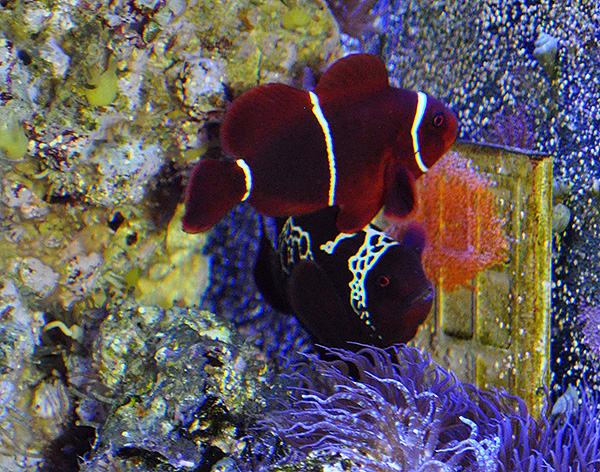


June 22nd, 2012
I was genuinely worried whether we’d have eggs 24 hours in. Thankfully, they proved to be good parents and good “clownfish”; the first spawn egg eating proved to be the typical first test run that so many clownfish seem to do. This batch, while I didn’t get a good photo of the parents, was doing well. The swelling on the Lightning Maroon’s eye had gone away. Phew.
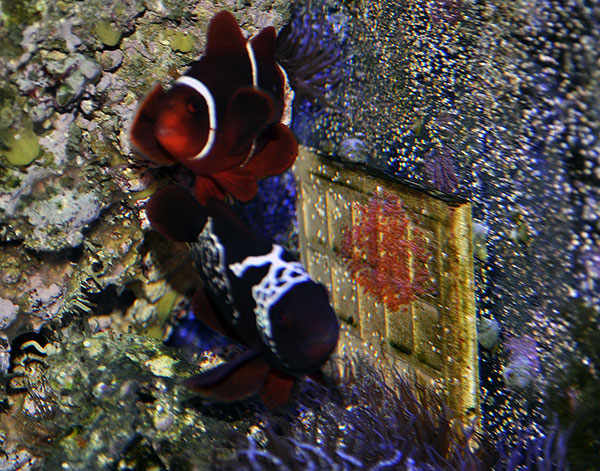
June 23rd, 2012
So much for resting easy about the health of the Lightning Maroon. The eggs were developing (a fair number that probably were infertile or diseased were removed by the pair), but some funky gunk (yes, that’s the scientific term) showed up on the Lightning Maroon’s right face. I was once again on high alert; this wasn’t pop-eye; this was more reminiscent of the mouth-rot I had to battle back a little while ago.

June 24th, 2012
So much for being on alert. By evening, things looked so bad on the Lightning Maroon’s face that I pulled the trigger and initiated the third course of treatment with Maracyn SW and Maracyn II SW in this system. The telltale bulge around the right eye had started to show as well. I felt I had little other option at this point; this fish is simply too valuable to take a wait and see approach when symptoms like these show up:

The eggs were looking good and developing fast, although I took little comfort in that given the current situation with the Lightning Maroon. The roller coaster of stress over this fish during the past couple months has been excruciating. No doubt, there were times I pondered whether it would all be easier if the fish just passed away – of course solely a passing fancy, but when things are clearly out of your real control, it is incredibly tough to sit there and do “what you can”. Of course, it’s a whole new level now that we are well within sight of the next major milestone in this 2+ year long project.

June 27th, 2012
June 27th represented the 4th day of Maracyn + Maracyn II treatments, and once again, it appeared I had potentially averted a crisis or loss. The condition of the Lightning Maroon was drastically improved. The eggs…the eggs were showing eyes? They had the classic silvery look of clownfish eggs before they’re going to hatch.

I had been worried that these eggs would be hatching out while I was on a trip to Boston to speak at the Boston Reef Society; but now, only 6 days post spawn, I was very worried that a hatch could come sooner than expected. The signs (and the data out there) said it was possible, sure, but maybe not likely? Still, if I waited too long and did nothing I could miss the hatch. Conversely, if I pulled the nest too early, I could miss killing the eggs before they actually had fully developed. Honestly though, I felt far less pressure about the decisions I was about to make than any of the disease-related issues with the Lightning Maroon; this is clownfish breeding, I can handle it.
There was really only one route to go – I had to sit and watch the tank. The lights go off at 12:15 AM, so I got things situated for a possible hatch. I used a small LED flashlight at the far corner of the tank as a larval attractant.

While waiting for the lights to go out, I prepared the area with buckets and siphons to take out larvae should they hatch in the tank.

Downstairs, I prepared a black round tub to receive broodstock water and possible babies.


Lights went out, and it was time to wait. All pumps were turned off through an extended feed timer on my Apex Lite (which would ensure they’d all come back on in the event that I somehow forgot about them and went to be). I did have to unplug the battery backup on the Vortech…can’t have babies going through that pump either. I’d check every once in a while, and initially got excited around 12:20 AM when I saw movement in the beam of the flashlight – until I realized it was copepods swimming around.

Many more checks turned up nothing, and I was starting to wonder if I had jumped the gun. Multiple plans of “what next” rolled around in my head, but they all disappeared at 1:23 AM on June 28th, 2012.

That is not a copepod. If you can’t really see it, maybe this one will help:

The moment that first baby clownfish showed up, I pulled the tile under almost complete darkness, moving it downstairs in a bucket with a lid and 5 gallons of water from the broodstock tank. I set it up for artificial hatching, and assumed that come morning, I’d see hundreds of clownfish swimming around. That was the hope…

June 28th, 2012
So much for hatching overnight. There was ONE baby in the tub. Terrific (<-sarcasm). 1 is better than none, so in the interest of keeping the one alive, I was forced to tinge the water green with a very light treatment of RotiGreen Nano, and a very small addition of rotifers (lest the baby starve).
The worst fear is that I had somehow killed the eggs in the move or prevented the hatch, which would have generally killed the eggs overnight. There was only one way to find out. I took a quick look at the tile.

And here’s what I saw…

They look perfectly fine. And what a great opportunity, thanks to the advent of digital photography and Photoshop, to get a headcount.

That’s roughly 310 eggs (each color group represents me counting to 50, with the scattered red dots representing the last 10 I counted). It’s not an exact headcount, but gives a great approximate number of eggs. Hardly the spawn of several thousand that some Maroon Clownfish are known to put down, but I’ll take it all the same. So very carefully, this tile went back into the black round tub…

…So long as the eggs didn’t die, there was still hope. The rest of the tension filled day was spent fighting the urge to recheck the tile for dead eggs. Come nightfall, I stuck with the photoperiod that the eggs had been used to, and turned the lights out in the basement a little early so that things were basically pitch black by 12:15 AM on June 29th. Just after 1:00 AM, a quick check with the flashlight caused me to announce to the world, “Ladies and Gentleman; we’re rearing Lightning Maroon Larvae.”
June 29th, 2012.
With only hours before my departure to Boston, I had to get things set up right. As the night progessed into the wee hours of morning (that we normally still call “night”), I fired up the lights, and checked the tile:

No stragglers – that means a 100% hatch. That means 300-ish baby maroon clownfish. 300 chances to see something really fantastic down the line. So long as we don’t botch rearing them!
Mike Doty, a fellow aquarist who happens to live 4 blocks away from me, had been over late (or early if you want to get technical) to see how things were set up and to know where everthing was…well that and to share a beer, toasting this milestone. Mike would be completely in charge of rearing the larvae in my absence.

While I got my share of incredulous inquiries about that, I actually had more confidence in Mike than myself; Mike had taken a pair of extra Maroons from me, spawned and reared a couple batches, so he was perfectly qualified in my book (I’ve done clowns, but never maroons before). We got the larval tub set up with greenwater and rotifers, and in the early afternoon I embarked on my all-day trek to Boston.

July 1st, 2012
I returned home from Boston in the afternoon, anxious to see how things had gone. Mike had kept me updated via texts during my absence and things sounded good. The main message I got from Mike was that my three rotifer cultures had failed to keep up with demand, and he had actually depleted his as well. I wondered, would we wind up losing this batch to starvation?!
July 2nd, 2012
I’m indeed burning through rotifers, but the cultures seemed to rebound and were producing enough for the moment. The rotifers in the BRT were also clearing out phytoplankton pretty frequently.

Mike and I had set up a drip for the tub using a spare brine shrimp hatchery and a micro ball valve from Julian Sprung’s Two Little Fishies. Not only is the drip good for top off, but also for introducing foods (phytoplankton) and ammonia control (CloramX) slowly.

Seeing that there were still many babies (some losses, but still many viable larvae), I took a photo for you all; your first look at what *Could be* a larval Lighting Maroon Clownfish, roughly 4 days old.

July 5th, 2012
Things have gone well, as I’ve slowly doubled the larval rearing volume to 10 gallons, keeping a watchful eye on the ammonia alert badge as I continue to feed 4-5 gallons worth of rotifers into the tub per day. With the warm basement temperatures (normally in the upper 60’s to lower 70’s, but lately 78F), the rotifer cultures are now roaring; I’m forced to feed them twice daily at a rate of 30 drops of RotiGrow Plus (and 30 drops CloramX).

I’ve done a couple pre-feeding rotifer enrichments with Super Selcon as well, just to keep the DHA levels up. However, today, now just before 7 days old, we reach another step in the rearing process. Today it was decided the larvae were finally ready to feed on APBreed’s TDO, size A. And after the second feeding, it was fair to say they are indeed consuming it.

So now we sit and wait. Any day now, we will catch the first glimpses of stripes as these larval Maroon Clownfish go through metamorphosis and settle out into juveniles. Most likely, I suspect that even if we have fish that will one day show the “Lightning” phenotype, we won’t see it at this stage in their development. But at this time, it is anyone’s guess. If you’re a betting man or woman, it’s time to place your wagers. Our first glimpse at the possibilities are just around the corner.
I am still owing the world a full post, but in the interest if simply keeping you all relatively updated, here’s some short tidbits.
Based on an egg photo count, there was 310 eggs on the tile and all hatched. There have been some larval losses, but that is to be expected. Mike Doty did an excellent job watching the babies in my absence – plenty of live larvae when I returned from Boston this past Sunday, July 1st.
Since returning, larval maintenance has been a study routine of upping the water volume with drips of pre-mixed saltwater (for those who will ask, I am currently using AquaCraft’s Marine Environment – they donated a palette of it for Banggai-Rescue). The SG is probably running around 1.021. I am using Reed Maricultures RotiGrow Plus to culture my rotifers, and using their RotiGreen Nanno for greenwater (I may have preferred the Omega variant, but Nanno is what I had on hand). I’ve been dosing RotiGreen and CloramX (a solution mixed from the powder) at roughly a 2:1 ratio, and averaging 30 drops twice a day now on the BRT. I have been harvesting up to 4 gallons of rotifer cultures daily (2 in the AM, 2 in the PM) to keep rotifer levels up. As of tonight, we are at basically 6 full days post hatch, so I introduced the larvae to their first taste of APBreed TDO (Top Dressed Otohime), Size A (smaller than the A1 I’m more normally accustomed to using). All is going well with these larvae, and I look forward to settlement soon.
The Lightning Maroon herself continues to be a problem…the Foureye has been removed for a while now, the Maracyn + Maracyn II treatment was long since done yet low level bacterial problems persist, most recently some very light markings on the male’s face, and then I found what looked like an enlarged light area on the leading spines of the left pelvic fin. These fish just can’t get a break. I am continuing to work with Dr. Kizer on some alternate ideas, as we’re really ruling out all the normal causes at this point. Me, I’m stumped. Without diagonistics, I think it’s fair to say that Dr. Kizer can’t really offer any other insights either. We may try yet another antibiotic course, another one dosed through the food, that seems to be where we’re heading. But I’m also thinking I don’t want to overreact either, so most likely we will try to have the prescription-based feed on hand, ready, should another large-scale problem crop up.



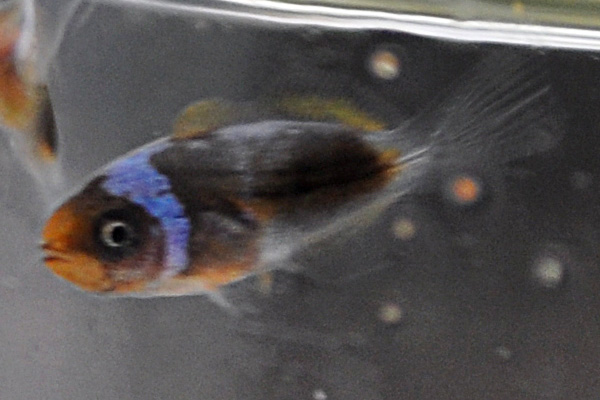



































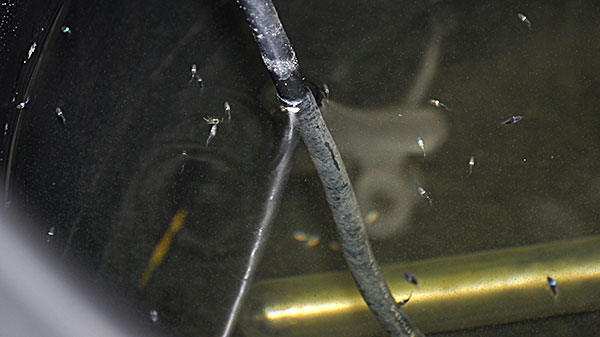





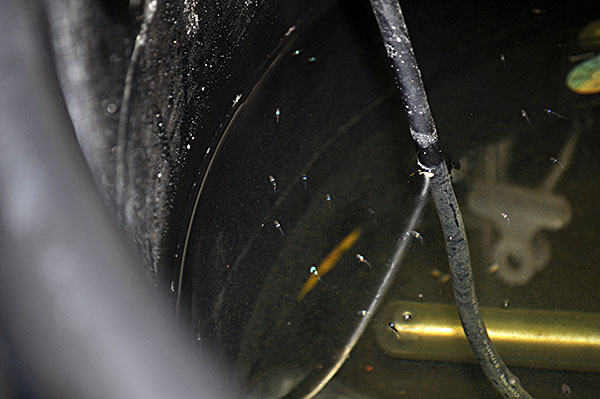






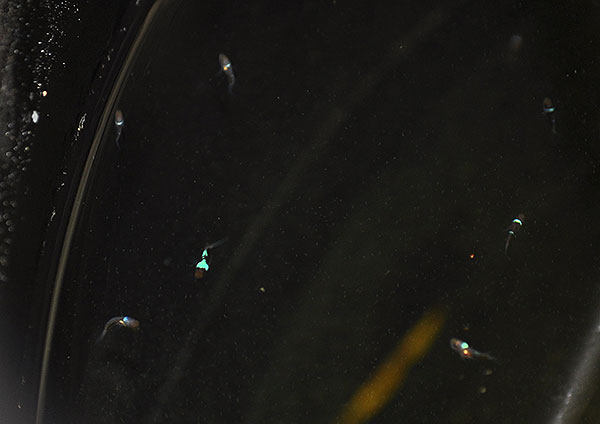




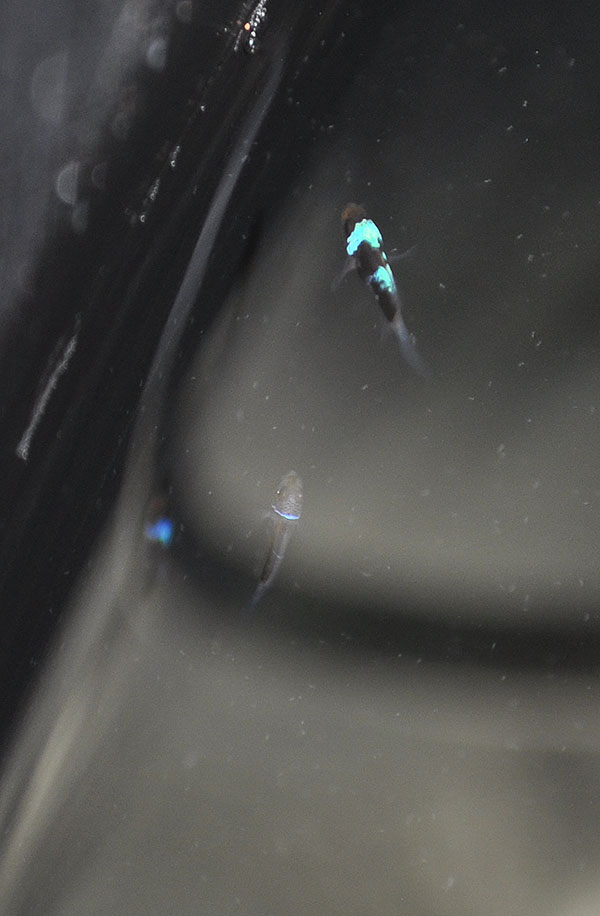


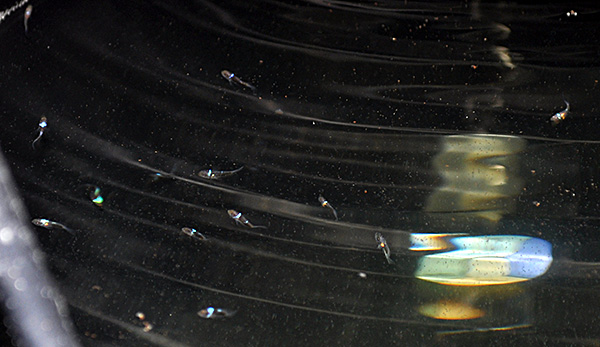










Recent Comments